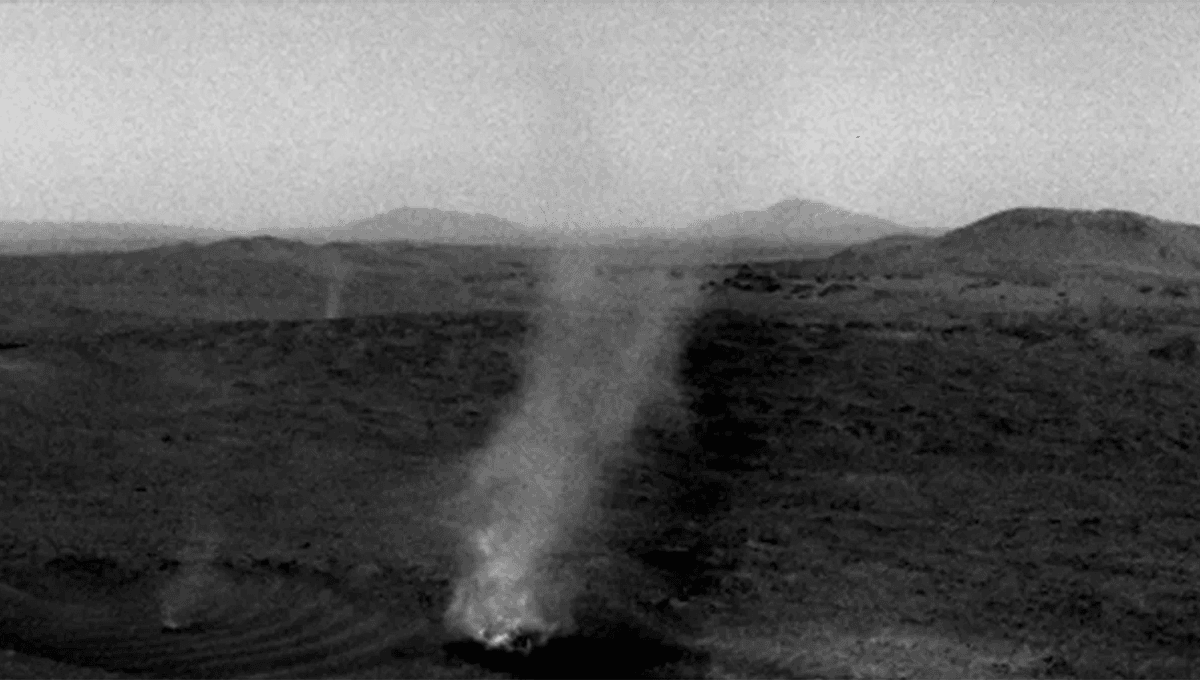
NASA’s Perseverance rover may have recorded evidence of a triboelectric discharge caused by a dust devil on Mars, according to a team who presented those findings at the 2025 Lunar and Planetary Science Conference (LPSC). If correct, the strength of the discharge is enough to suggest that lightning could be created within Martian dust devils.
Dust devils have been seen on the Red Planet before. In fact, we even know what they sound like, and have witnessed one dust devil devouring a second dust devil in the Witch Hazel Hill area of the Jezero Crater. While cool to see this weather phenomenon on another planet, and one with a far more sparse atmosphere, this could cause a little trouble for our Martian robots. Not because they’ll be picked up by a dust devil – they are far too large, and the dust devils too weak – but because they could act like dust devils on Earth.
“Electrification of airborne dust is a known phenomenon on Earth, caused by charge transfer from collisions and frictional contact between windblown particles,” an international team explained in a paper presented at LPSC 2025.
“The physics of this triboelectric charging is still poorly understood, but experimental observations indicate that large particles tend to be positively charged, while smaller particles tend to be negatively charged. As smaller particles undergo turbulent ascent, larger particles fall to the ground, creating a charge separation that results in the generation of intense electric fields. Such strong electric fields have been observed in both dust storms and dust devils on Earth.”
While electrified dust sounds “cool as hell”, these electric fields can lead to electric discharges, which could pose a problem to NASA’s rovers.
“These phenomena play a critical role in dust dynamics by introducing an electric force that affects the motion of these charged particles, ultimately enhancing the lifting of dust into the atmosphere,” the paper continues.
“When electric fields exceed the atmospheric breakdown threshold potential (~3MV/m on Earth), this can occasionally lead to remarkable discharge events, resulting in ionization of the surrounding atmosphere, as evidenced in volcanic ash plumes.”
Earlier this year, one team suggested that the charge build-up may be enough to create lightning inside dust devils.
“The dust, which exhibits vertical and lateral size distributions within the dust devils, gets charged due to triboelectric charging. The charge separation in this process and weak atmospheric conductivity might yield a massive charge buildup and large electric fields within the vortex,” the team explained in their paper. “For certain dust-atmospheric conditions, its magnitude is shown to exceed the atmospheric breakdown value, which may trigger lightning in the dust devils on Mars.”
According to that team, the chances of detecting lightning within a Martian dust devil could be difficult, but could be realistically done with larger atmospheric dust loading. But here’s where it gets interesting: according to the team presenting their work at LPSC 2025, the Perseverance rover may have picked up evidence that charge within dust devils on the planet can hit this critical atmospheric breakdown value.
The team explains that on Sol 215, the SuperCam microphone onboard the Perseverance rover was on as a dust devil passed over it. Separating out the resulting noise, for example from dust grains impacting the microphones, they found a “very sharp and intense signal”. The signal was a positive, high-amplitude peak, shortly followed by a relaxation, before a second peak and relaxation. The relaxation, according to the team, is likely the response of the microphone’s internal electronics to the electromagnetic field radiated from an atmospheric discharge. Following laboratory experiments aimed at replicating the signal, they conclude that it was indeed likely the result of an atmospheric discharge.
“This observation by the SuperCam microphone constitutes the first direct detection of a triboelectric discharge in the atmosphere of Mars,” the team writes in their conclusion. “It thereby demonstrates that the electric field in a dust devil can reach 25 kV/m, a level corresponding to the expected breakdown threshold of the Mars atmosphere.”
In short, there are dust devils on Mars, and they may be producing lightning. While this remains “cool as hell”, lightning-producing dust devils may be a problem for missions such as the Mars sample return, or future crewed missions to the planet, as well as to the rovers already in situ. The team plans further investigations into the phenomenon and any risks it may pose.
The research was presented at LPSC 2025. The second paper is published in Physics of Plasmas.
Source Link: NASA's Perseverance Rover May Have Recorded Evidence Of Electrified Dust Devils On Mars